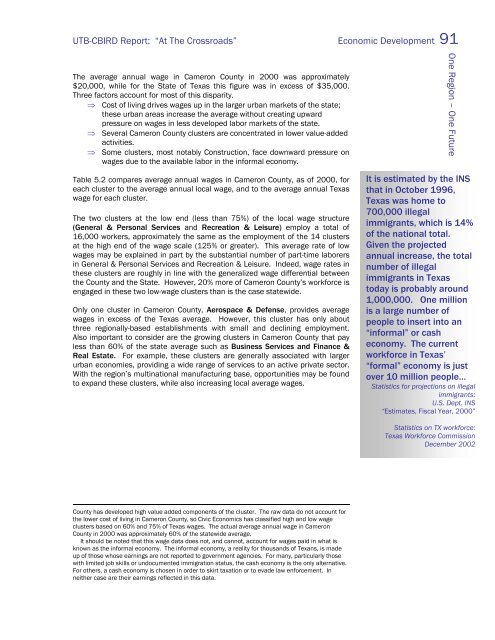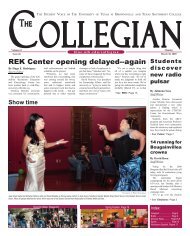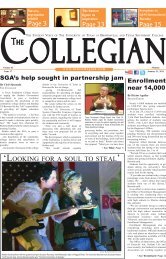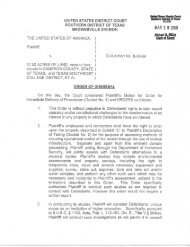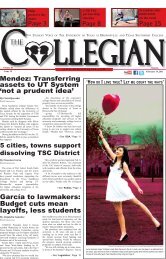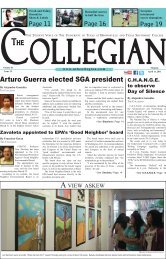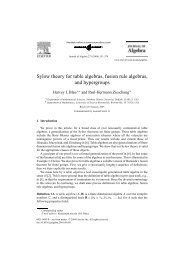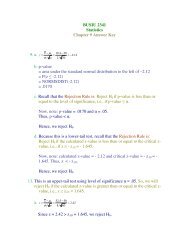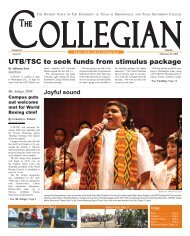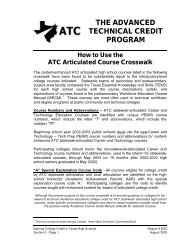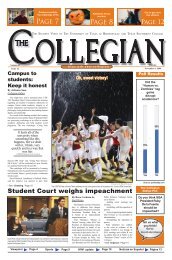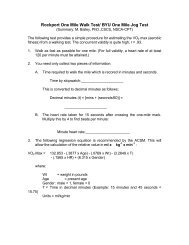cameron county/matamoros - blue - The University of Texas at ...
cameron county/matamoros - blue - The University of Texas at ...
cameron county/matamoros - blue - The University of Texas at ...
Create successful ePaper yourself
Turn your PDF publications into a flip-book with our unique Google optimized e-Paper software.
UTB-CBIRD Report: “At <strong>The</strong> Crossroads” Economic Development 91<br />
<strong>The</strong> average annual wage in Cameron County in 2000 was approxim<strong>at</strong>ely<br />
$20,000, while for the St<strong>at</strong>e <strong>of</strong> <strong>Texas</strong> this figure was in excess <strong>of</strong> $35,000.<br />
Three factors account for most <strong>of</strong> this disparity.<br />
⇒ Cost <strong>of</strong> living drives wages up in the larger urban markets <strong>of</strong> the st<strong>at</strong>e;<br />
these urban areas increase the average without cre<strong>at</strong>ing upward<br />
pressure on wages in less developed labor markets <strong>of</strong> the st<strong>at</strong>e.<br />
⇒ Several Cameron County clusters are concentr<strong>at</strong>ed in lower value-added<br />
activities.<br />
⇒ Some clusters, most notably Construction, face downward pressure on<br />
wages due to the available labor in the informal economy.<br />
Table 5.2 compares average annual wages in Cameron County, as <strong>of</strong> 2000, for<br />
each cluster to the average annual local wage, and to the average annual <strong>Texas</strong><br />
wage for each cluster.<br />
<strong>The</strong> two clusters <strong>at</strong> the low end (less than 75%) <strong>of</strong> the local wage structure<br />
(General & Personal Services and Recre<strong>at</strong>ion & Leisure) employ a total <strong>of</strong><br />
16,000 workers, approxim<strong>at</strong>ely the same as the employment <strong>of</strong> the 14 clusters<br />
<strong>at</strong> the high end <strong>of</strong> the wage scale (125% or gre<strong>at</strong>er). This average r<strong>at</strong>e <strong>of</strong> low<br />
wages may be explained in part by the substantial number <strong>of</strong> part-time laborers<br />
in General & Personal Services and Recre<strong>at</strong>ion & Leisure. Indeed, wage r<strong>at</strong>es in<br />
these clusters are roughly in line with the generalized wage differential between<br />
the County and the St<strong>at</strong>e. However, 20% more <strong>of</strong> Cameron County’s workforce is<br />
engaged in these two low-wage clusters than is the case st<strong>at</strong>ewide.<br />
Only one cluster in Cameron County, Aerospace & Defense, provides average<br />
wages in excess <strong>of</strong> the <strong>Texas</strong> average. However, this cluster has only about<br />
three regionally-based establishments with small and declining employment.<br />
Also important to consider are the growing clusters in Cameron County th<strong>at</strong> pay<br />
less than 60% <strong>of</strong> the st<strong>at</strong>e average such as Business Services and Finance &<br />
Real Est<strong>at</strong>e. For example, these clusters are generally associ<strong>at</strong>ed with larger<br />
urban economies, providing a wide range <strong>of</strong> services to an active priv<strong>at</strong>e sector.<br />
With the region’s multin<strong>at</strong>ional manufacturing base, opportunities may be found<br />
to expand these clusters, while also increasing local average wages.<br />
County has developed high value added components <strong>of</strong> the cluster. <strong>The</strong> raw d<strong>at</strong>a do not account for<br />
the lower cost <strong>of</strong> living in Cameron County, so Civic Economics has classified high and low wage<br />
clusters based on 60% and 75% <strong>of</strong> <strong>Texas</strong> wages. <strong>The</strong> actual average annual wage in Cameron<br />
County in 2000 was approxim<strong>at</strong>ely 60% <strong>of</strong> the st<strong>at</strong>ewide average.<br />
It should be noted th<strong>at</strong> this wage d<strong>at</strong>a does not, and cannot, account for wages paid in wh<strong>at</strong> is<br />
known as the informal economy. <strong>The</strong> informal economy, a reality for thousands <strong>of</strong> Texans, is made<br />
up <strong>of</strong> those whose earnings are not reported to government agencies. For many, particularly those<br />
with limited job skills or undocumented immigr<strong>at</strong>ion st<strong>at</strong>us, the cash economy is the only altern<strong>at</strong>ive.<br />
For others, a cash economy is chosen in order to skirt tax<strong>at</strong>ion or to evade law enforcement. In<br />
neither case are their earnings reflected in this d<strong>at</strong>a.<br />
One Region – One Future<br />
It is estim<strong>at</strong>ed by the INS<br />
th<strong>at</strong> in October 1996,<br />
<strong>Texas</strong> was home to<br />
700,000 illegal<br />
immigrants, which is 14%<br />
<strong>of</strong> the n<strong>at</strong>ional total.<br />
Given the projected<br />
annual increase, the total<br />
number <strong>of</strong> illegal<br />
immigrants in <strong>Texas</strong><br />
today is probably around<br />
1,000,000. One million<br />
is a large number <strong>of</strong><br />
people to insert into an<br />
“informal” or cash<br />
economy. <strong>The</strong> current<br />
workforce in <strong>Texas</strong>’<br />
“formal” economy is just<br />
over 10 million people…<br />
St<strong>at</strong>istics for projections on illegal<br />
immigrants:<br />
U.S. Dept. INS<br />
“Estim<strong>at</strong>es, Fiscal Year, 2000”<br />
St<strong>at</strong>istics on TX workforce:<br />
<strong>Texas</strong> Workforce Commission<br />
December 2002


